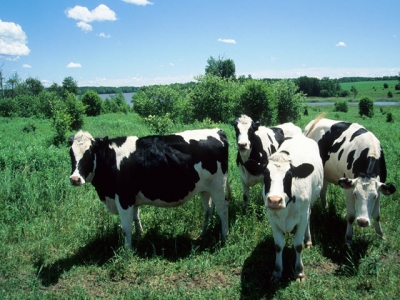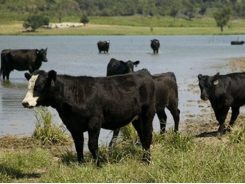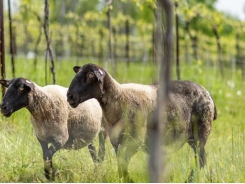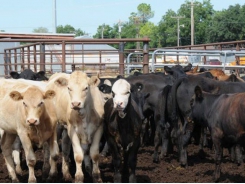Spiced-up ration may improve cattle health

Research at New Mexico State University's value-added agriculture center examining use of chili pepper byproducts to treat inflammation in livestock.
The New Mexico State University (NMSU) College of Agricultural, Environmental & Consumer Sciences is developing a Center of Excellence on Sustainable Food & Agricultural Systems (CESFAS), and one of its potential projects is treating inflammation in livestock by supplementing their diet with capsaicin-rich chili peppers.
CESFAS, proposed by New Mexico Gov. Michelle Lujan Grisham, will be developed in association with General Obligation Bond D, which voters passed by a margin of more than 65% in November 2018. The vision is to build a sustainable, vibrant food and agricultural economy in New Mexico through value-added research and education, NMSU said in its announcement.
“Value-added agriculture will help grow New Mexico’s economy, and NMSU’s Center of Excellence on Sustainable Food & Agricultural Systems will be a driving force for that growth,” college dean Rolando A. Flores said.
Other proposed areas of research include: nutraceutical and functional foods; specialty markets for meat and produce; food safety and food security; valued-added textiles, value-added agribusiness and agricultural supply chain entrepreneurship; food, agriculture and natural resource policy; agricultural and culinary tourism, and sustainable water systems.
Clint Löest, animal nutritionist and professor of animal and range sciences, and his graduate students are exploring the chili capsaicin as an alternative strategy to improve livestock health. Each year, diseases in cattle cost the U.S. beef industry an estimated $600 million, and there’s growing pressure from consumers to minimize drug use with alternative methods, NMSU said.
“If capsaicin is effective at reducing inflammation, then supplementing livestock diets with chili peppers could reduce traditional anti-inflammatory drug use and increase the market for culled chili peppers by $10 million annually, a win-win situation for the chili pepper and livestock industries,” Löest said.
The current research builds on previous value-added agriculture studies involving chili peppers and livestock. In a 2004 study, NMSU researchers found that cows preferred a diet containing 20% chili pepper byproducts over a corn silage-based diet without them.
Chili pepper byproducts, such as culled pods, peels, veins, leaves, seeds and stalks, offer many benefits, NMSU said, noting that these byproducts are highly nutritious, containing more protein and minerals than corn silage — a major source of feed for dairy cattle in New Mexico — and they’re widely available at little to no cost. Nationwide, the process of peeling, deseeding and deveining chili peppers yields more than 30 million lb. of byproducts every year.
As for the current research, Löest and his students are still exploring ways capsaicin can be used to treat inflammation in ruminants. Similar studies have shown success in non-ruminants, Löest said, but ruminant animals, such as cattle, present different challenges.
“We’ve done two or three studies already, but we could not duplicate what they found in non-ruminants,” he said. “We discovered it’s possibly because the rumen is destroying the capsaicin. We have to now rethink how we’re going to protect the capsaicin that’s in the chili.”
Hemp research
NMSU researchers at the new CESFAS also plan to study the value-added properties of hemp, following the plant’s legalization in 2018.
Earlier this year, researchers outlined their hemp research and education proposals in a white paper, identifying five areas of hemp research expertise and interest. The report called for the development of a comprehensive hemp research and extension center at NMSU, with a projected cost of $9.1 million over four years.
“Hemp could have many practical uses throughout New Mexico,” Flores said. However, he stressed that hemp research at NMSU would not happen immediately because it needs funding.
In the proposal, researchers said NMSU could help producers maximize use of the entire plant and extract useful proteins, oils and antioxidants from the seeds. Hemp proteins, for example, could be used in functional foods, nutraceuticals and extruded snacks and aquaculture feed.
Among other applications, hemp could help absorb heavy metals from soil and suppress weeds and soil-borne pathogens. Additionally, hemp could be an excellent source of protein, making it a competitive alternative in livestock feeds with ethanol industry co-products and animal byproducts, NMSU said.
Related news
Tools

Phối trộn thức ăn chăn nuôi

Pha dung dịch thủy canh

Định mức cho tôm ăn

Phối trộn phân bón NPK

Xác định tỷ lệ tôm sống

Chuyển đổi đơn vị phân bón

Xác định công suất sục khí

Chuyển đổi đơn vị tôm

Tính diện tích nhà kính

Tính thể tích ao




 Systems project examines sustainability of Iowa cow/calf sector
Systems project examines sustainability of Iowa cow/calf sector  Midwest cattle face potential heat stress
Midwest cattle face potential heat stress